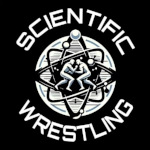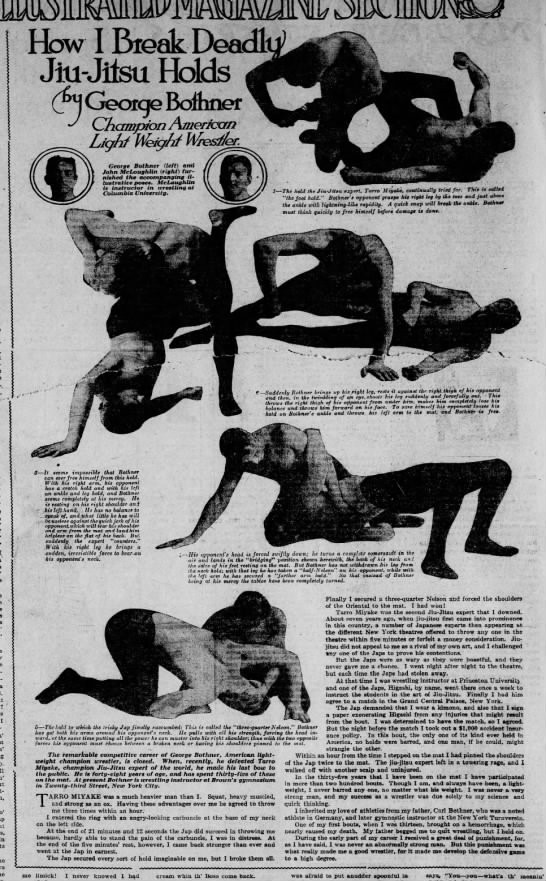
BEFORE MMA #2 - East Meets West-1905: Catch-As-Catch-Can Takes on Jiu-Jitsu
Lancashire catch-as-catch-can wrestling was developed in the Lancashire district of England in the 18th century. Its origin was based on the ancient Up and Down Fighting brought to that area by the Flemish weavers. These craftsmen from Flanders began coming to England in the 1300's to work in the textile trade and later to escape persecution as Protestant Christians during the War of the Spanish Succession. Up and Down Fighting was a brutal art that involved not only ground grappling, but also kicking, strangling, eye-gouging, head-butting and submission holds. Competitors even wore spiked boots during these savage matches. The fighting style was eventually modified somewhat and sanitized into Lancashire catch-as-catch-can when it became a popular professional sport in the mid-18th century (1). Pro catch wrestlers like Edwin Bibby, Joe Acton, Tom Connors, Jim Faulkner and Jim Parr took their unique grappling style across the Atlantic Ocean where it experienced tremendous growth.
As Lancashire catch-as-catch-can wrestling began to be popularized in North America in the late 19th century, it was sometimes referred to as "rough-and-tumble wrestling" to distinguish it from other wrestling styles with stricter rules and regulations. There is a long association between rough-and-tumble fighting and catch wrestling and they share a lot of common heritage. Most rough-and-tumble fighters incorporated a lot of grappling methods into their arsenal and many catch wrestlers were also adept at rough-and-tumble. In fact, American catch wrestlers employed rough-and-tumble tactics when they first faced the challenge of the Japanese martial arts invasion.
Beginning at the turn of the twentieth century Japanese martial arts, with its long and storied history, began making its introduction into the western world, North and South America and Europe. The west already had its own established combat sports, notably boxing and wrestling, so a confrontation was inevitable. Or to state it better, many confrontations were inevitable. The actual skill level of the early "martial arts evangelists" varied. Some of the Nipponese martial artists were legitimate Judoka from Kano's Kodokan. Various older jiu-jitsu schools were also represented. Some initially sought only to give demonstrations and teach their arts to the military and police. Others immediately sought out professional opportunities with circuses, the vaudeville theater circuit and professional wrestling, going the "taking on all comers" route. The Japanese fighting arts carried an aura of mystery and the practitioners were believed to have almost supernatural powers at bone-breaking, utilizing "nerve holds" and dealing out "death touches".
One of the first "jiu-jitsu versus wrestling" contests to gain national attention in the U.S. pitted Katsukuma Higashi against the well-known lightweight champion catch wrestler George Bothner. Higashi arrived in the United States in the early 1900's and established himself as a New York-based jiu-jitsu expert and teacher. He was said to have formerly taught the martial art at Doshisha College in Kyoto, Japan and to be descended from a samurai clan. There is some debate about his actual background. Some indications are that Higashi had been trained in Tsutsumi Hozan-ryu jiu-jitsu. He claimed to teach the "Kano system" (Kodokan judo). Whatever the case Higashi practiced what has been described as "generic jiu-jitsu". At a diminutive 5'3- and 120 pounds, he announced that he was ready and willing to put his skills to the test against any western wrestler or boxer who dared take him on.
Higashi boldly issued a challenge to heavyweight boxing champion James J. Jeffries in March of 1905. When boxer Jack Blackburn expressed his willingness to battle it out with the martial artist, Higashi drew the "color line" and said, "he does not like to meet a negro" (2). On another occasion Higashi gave a demonstration in Tuxedo Park, NY. Alex Swanson and another wrestler also gave an exhibition and afterwards challenged Higashi and his partner to wrestle. Higashi turned to the club officials and asked them if they were ready to be responsible for any serious injuries or fatalities that might occur. Nothing came of the challenge and the Americans accused the Japanese of using their cautionary warning merely as an excuse to avoid a contest (3).
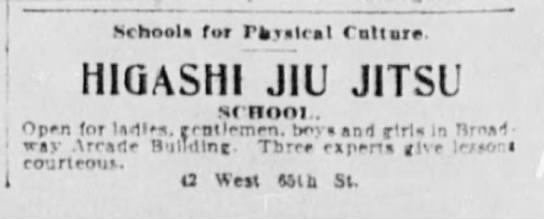
Heavyweight wrestling champ Tom Jenkins counter-challenged Higashi or "any expert of jiu-jitsu" to meet his protégé Clarence Bouldin, "the Cuban Wonder" in an "anything goes" rough-and-tumble bout. Jenkins commented, "The work of jiu-jitsu reminds me of the rough and tumble style in which the purpose is to put your opponent out of business. Of course, there are many ways of beating an antagonist in a brawl, for which the Japanese method is especially commended, but it does not seem at all likely that the user of jiu-jitsu is going to have matters all his own in such a scrimmage. It is an easy thing after you have obtained a hold to overcome an opponent, but he certainly is not going to remain passive while you are getting that hold" (4).
Higashi teamed up with one of the early American jiu-jitsu proponents H. Irving Hancock. Hancock was a chemist, war correspondent, and prolific writer. Together they authored The Complete Kano Jiu-Jitsu. It was published in 1905 and became a martial arts classic. Higashi was touted as "the greatest jiu jitsu expert" now in this country "and it was claimed he can kill a man in several seconds simply by pressing on the back of his neck or on his spine" (5). One of Higashi's early advertisements stated that Jiu-Jitsu "gives the weakest women the power to overcome the most powerful man. It is the most scientific method of self-defense known to man, and is more effective than pistol, club or knife. It is the application of the unexpected. An adversary or foe finds his muscles suddenly paralyzed or himself placed in such a position that resistance leads to unbearable pain or broken bones".
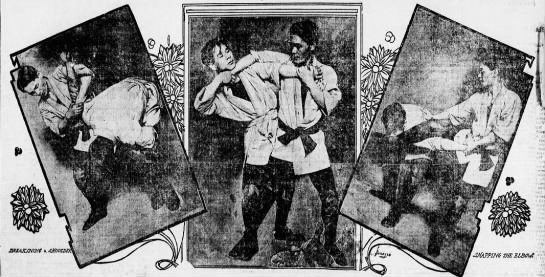
Bothner was a master catch-as-catch-wrestler and the current claimant of the world lightweight wrestling championship. A former amateur champion, he had been a professional wrestler since 1896 and also served as the mat coach for Princeton University. As one sportswriter described, "Bothner was without a doubt the most clever and versatile wrestler in the country." He was known as "the handicap king" due to his penchant for taking on heavier opponents in handicap contests. Even tough Tom Jenkins was unable to throw Bothner the agreed upon number of times in one such bout (6).
The wrestling fraternity was growing restless at both the jiu-jitsu men's bold claims and the media and the public's fascination with them. Bothner was ready to take up their gauntlet. Initially he tried to make a match with jiu-jitsu expert Waraubo Hakowi. When that proposed match fell through, he set his sights on Higashi. Higashi expressed his willingness to comply with Bothner's challenge. He told sportswriter Robert Edgren, "I must be careful not to hurt Mr. Bothner. He seems a very nice man, and I would not like to kill him or break any of his bones. Of course most of the tricks are fatal. There are only a few simple ones that I can use in wrestling. If I were free to use any of them I could easily defeat any wrestler or boxer…More than a thousand years ago, perhaps, but now you cannot kill men in a public contest. It would be like a bull fight if I used the secret tricks. I could kill a man just as the bull fighter kills a bull" (7).
Higashi furthermore declared that the recently held contests between American wrestlers and "self-proclaimed jiu-jitsu experts" were not good examples of the prowess of the martial art. He proclaimed, "Those Japanese who have been defeated are not capable exponents of our national Japanese art. In Japan they would not be seriously considered as exponents of the work. I desire to assure the American public that these countrymen of mine know nothing of the real practice of jiu jitsu. They are parading the scanty knowledge that they obtained at school when boys…I am ready at any time to meet any American wrestler, and am confident of my ability to overcome any opponent through the use of jiu jitsu methods" (8). The Higashi and Bothner camps began ironing out the details of the upcoming battle. They would contest under a combination of catch-as-catch-can and jiu-jitsu, ceremoniously dubbed "official mixed-style Japanese jiu-jitsu rules". Strangle and choke holds would be allowed, but otherwise it would be a grappling bout, winnable by pinfall, submission or choke-out. The issue of just what constituted a fall became a hot topic. Higashi insisted that flying falls be counted. A flying fall was gained when one contestant's shoulders touched the mat even for the briefest moment. It could be called while both men were scrambling about the mat, and not just due to one wrestler forcibly pinning the other down. Flying falls were highly controversial and very unpopular with the fans.
Higashi also demanded that both contestants wear traditional jiu-jitsu jackets, called "kimonos" at the time. Bothner objected and instead offered to wrestle in alternating falls with and without the kimono. The jiu-jitsu artist wouldn't budge on that point and the catch wrestler reluctantly conceded. He did hold his ground on the choice of referee however and rejected Higashi's choice of using his associate Hancock as the third man in the ring. Well-known sports authority Tim Hurst was selected to serve as the referee. Hancock would be Higashi's ringside judge. Bothner would have in his corner Professor John J. O'Brien. The Professor had been familiarizing Bothner with the ins and outs of the Japanese art. O'Brien was a veteran wrestler and police self-defense instructor and had studied jiu-jitsu in Japan in the 1880s. One of O'Brien's pupils was no less than President Theodore Roosevelt.
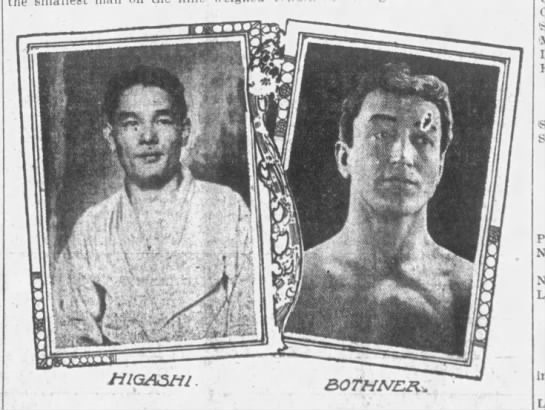
The contest was set to take place April 6, 1905 in New York City at the Grand Central Palace. Preliminaries included a jiu-jitsu rules match between Kona and Kargo, and Alex Swanson in a catch wrestling handicap bout. Swanson would take on two opponents one after the other. A crowd estimated at some 4000 people gathered to see what was hoped to be an epic confrontation. The bout had stirred up wide-spread attention. A good number of Higashi's countrymen were on hand to support him. Likewise a contingent of Princeton students were present to back their coach. Edgren commented, "Most people who came expected to see the little brown man break Bothner's bones" (9).
Higashi had even demanded that his opponent sign a waiver exonerating him from any serious or fatal injuries resulting from his use of jiu-jitsu. It was rumored that Bothner even purchased a life insurance policy before going into the match. Higashi was said to have weighed in at 118 pounds, about twenty pounds less than Bothner. The men wore "kimono" jackets and belts into the ring, Higashi entered first. Higashi complained that at the last minute he was forbidden to use any of his "dangerous tricks", like joint-twists and open-hand strikes. Bothner would later state that the jackets had been furnished by Higashi's camp and that his was very loose and ill-fitting and even had a hand hold cut into the back of it. Higashi remained adamant about allowing flying falls, even refusing to go on otherwise. When the announcer made this known to the crowd, he was greeted by boos and jeers.
The two gladiators from different corners of the globe met in the center of the ring and shook hands. Time was called and the battle commenced. "Higashi immediately assumed the role of aggressor. He went right after Bothner, grabbing his collar with both hands. The jiu-jitsu expert was working methodically to tighten the folds of the jacket around Bothner's throat and choke him out. O'Brien had coached the American in advance in defending himself against this tactic, so he quickly pulled some slack into his collar, although try as he might, he couldn't shake Higashi loose. Higashi maintained the grip and proceeded to pull Bothner down to his knees. He then wrapped an additional fold of cloth over Bothner's face, but the catch wrestler resisted, broke free, and rose to his feet. Higashi attacked again, latched onto Bothner's collar, and forced him to the mat, all the while working to choke the breadth out of his opponent. The American was warily biding his time, defending himself against the choke hold, and waiting for an opening. Higashi kept busy tugging, pulling, and twisting the cloth around Bothner's neck while holding him down firmly. In the midst of the struggle, Higashi lost his grip. Like a lightning bolt, Bothner went into action. He dropped to one knee and grabbed his antagonist's right leg with his left hand. Bothner's work was likened to an octopus using its tentacles" (10). For the first time Higashi was on the defensive, and he struggled wildly. Bothner continued to unleash his catch-as-catch-can arsenal. He secured a neck hold, cinched up on the leglock, and slowly pressed his advantage. With almost irresistible grappling skill, Bothner slowly and decisively planted Higashi's shoulders squarely on the canvas. Bothner was awarded the first fall after 14 minutes and 35 seconds of grueling battle. Higashi refused to stop wrestling and held onto Bothner from the bottom position, Referee Hurst finally managed to separate the grapplers, and Bothner rose up to deafening applause.
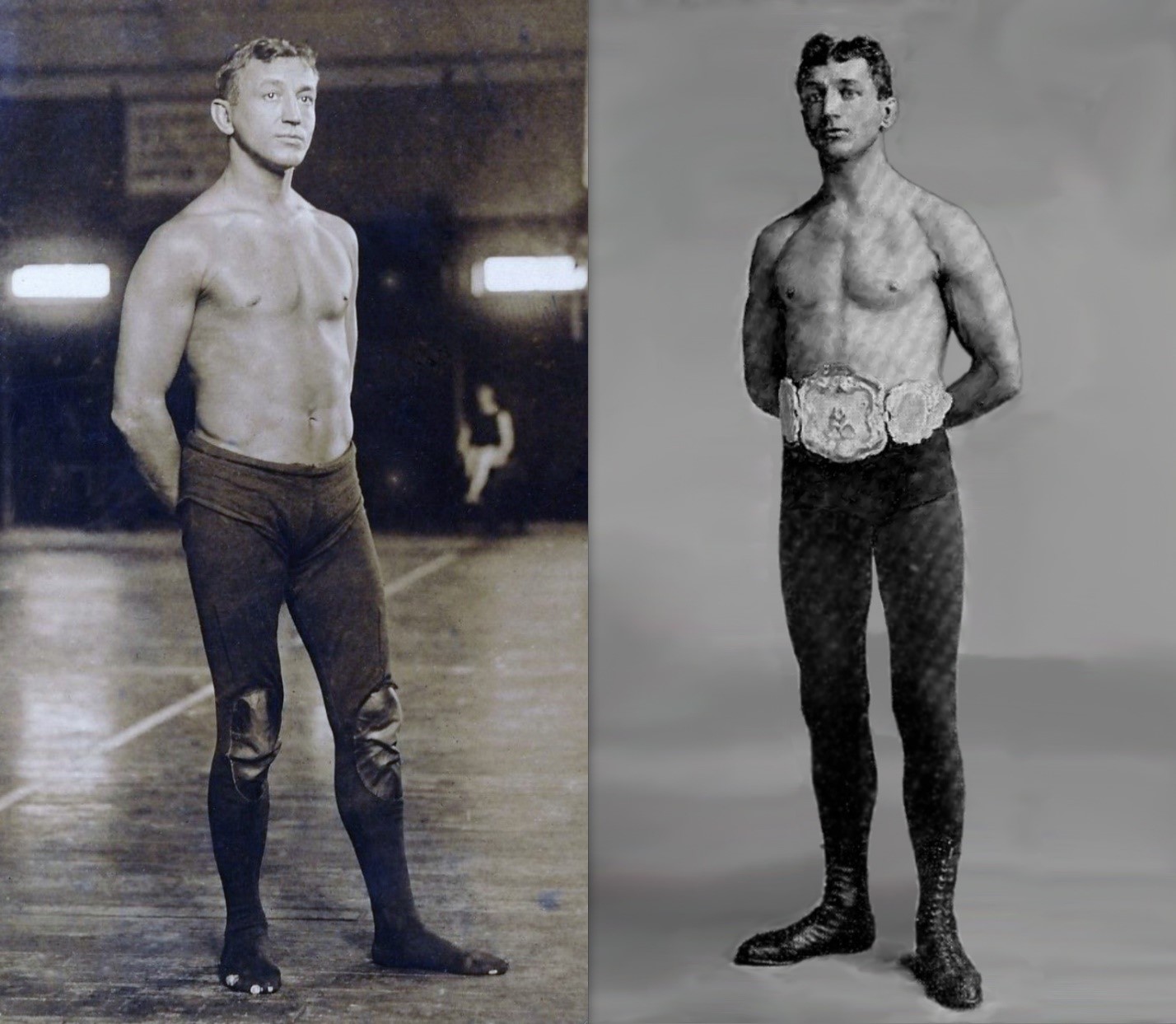
The contestants took the customary 15-minute break before resuming the match. Higashi came out furious and aggressive and soon had Bothner down on all fours while holding tight with a 'death grip' around the American's collar. Higashi was cautious of his adversary's catch techniques and stayed at arm's length, keeping his legs out of reach. The jiu-jitsu expert kept working to tighten the folds of the jacket while Bothner struggled to keep enough slack in his collar to allow him to continue breathing. Bothner tried unsuccessfully to release himself from Higashi's two-hand hold. He also attempted to seize one of Higashi's well-protected legs but failed. After a clever maneuver that brought Bothner in close, he lunged and broke Higashi's grip. The Japanese grappler retaliated by clamping on a half-nelson. Bothner perked up at this familiar hold, countered it with ease, and became the aggressor. He attempted to secure a choke hold, but Higashi fended it off. They were wrestling about the mat and sparring for holds. Higashi got his usual collar grip locked on and kept his legs out of Bothner's reach. Higashi dropped one hand and tried to grab one of the American's legs but failed.
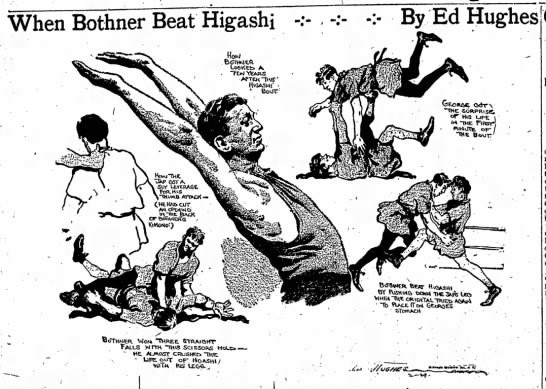
Higashi and Bothner were in a seeming stalemate when the referee warned them to pick up the pace. Some fast groundwork followed, which drew loud approvals from the crowd. Higashi suddenly stood up and accused Bothner of deliberately head-butting him. The ref waved his claim off and told them to continue wrestling. They tied back up and scrambled about. Higashi executed a move known as tomoe-nage, or a stomach throw. He deftly planted one foot in Bothner's stomach, fell to his own back, and sent his adversary sailing head over heels. As Bothner bounded back to an upright position, Higashi and Hancock excitedly claimed a flying fall. O'Brien entered the fray and insisted that Bothner's shoulders never touched the mat. The referee ruled in the American's favor and ordered them to return to the battle, adding that if another fall wasn't gained within the next 20 minutes, he would call the match a draw.
Higashi tore into Bothner and after some fast work tossed him airborne with another stomach throw. Again he claimed a flying fall. This time it was clearly observed that Bothner had avoiding landing on his shoulders. Ordered by Hurst to get busy, they mixed it up until Bothner took Higashi down with a body hold. Bothner wrestled into a neck and crotch hold and slowly levered his opponent down for a pinfall. Hurst awarded a second fall to Bothner. The men had been grappling for a total of 1 hour and 31 minutes. It was noted that Bothner's head and neck were badly bruised from Higashi's handiwork. The Japanese martial artist was upset and refused to continue. Higashi, backed up by Hancock, asserted that he had gained three falls from his opponent and had already won the contest. Beyond the two debatable flying falls, what constituted the third fall was unclear. Higashi was insistent. Hancock later stated, "We claim three falls tonight by the rules of jiu-jitsu…Higashi has clearly won."
Higashi was convinced to continue the match by some Japanese backers. Bothner wrestled confidently and used a crotch hold to pin his antagonist after 15 minutes and 20 seconds. Higashi and Hancock disputed that an actual fall had occurred, but much to their chagrin Hurst awarded the fall and the match to Bothner. The Brooklyn Daily Eagle reported the following day: "The death knell of jiu-jitsu, the favorite wrestling and bone-breaking pastime of the Orient, was sounded last night". The New York Times chimed in with, "…George Bothner threw Higashi three times last night…The Little Jap threw George at least once, flat on his back, but the flying tails of Bothner's kimona probably blinded referee Tim Hurst for he didn't see the fall." (11). Officially Higashi was defeated, but he did not concede the loss. He insisted that he had won three falls. He stated, "It had been agreed that a flying fall should count. I made two in succession, each time hurling Mr. Bothner over my head. My judge claimed the falls for me, but they were disallowed, although explicitly provided for in the final agreement. Then I secured another well-known jiu-jitsu fall by folding my opponent's arms around me and going over backwards, landing him under me on his back. All these falls are allowed under the Japanese rules..." Higashi also challenged the qualification of Hurst to have served as the referee due to his unfamiliarity with jiu-jitsu (12).
In recalling the contest in the ensuing years, Bothner alleged that Higashi used the stomach-throws as an opportunity to deliver a powerful kick straight into his groin. He admitted that he retaliated in kind, and before effecting the final fall he shot a swift knee into his opponent's groin. He further reflected, "I suffered more injuries that day than in any other contest I had ever engaged…It was a test as to which could hold out the longer. I knew that if I weakened I would be so badly garroted that I could not continue the match, and that I might even get a broken neck…I began to wheeze, spots danced before my eyes, and I felt my face suffused with blood…When he began to garrote me, I'll remember that if I live to be a hundred" (13).
Robert Edgren summed up his take on the Bothner/Higashi fight by penning, "When Higashi met Bothner in New York, and in several other alleged jiu jitsu encounters, all kicks and bone-breaking grips were barred. The jiu jitsu artist was limited to playing the wrestler's game" (14). The sportswriter was echoing the sentiment frequently voiced over the years by martial arts-based fighters that in public style-versus-style contests they were not allowed to use their full repertoire of brutal hand-to-hand combat techniques and thus were not able to fully demonstrate their capabilities and prowess.
Higashi did not take his defeat by Bothner lightly and he sought another chance to prove the merits of jiu-jitsu over western grappling. A round of challenges and negotiations began between the Japanese martial artist and pro wrestler Alex Swanson. Swanson claimed the catch-as-catch-can welterweight championship of the world, based on his defeat of Harvey Parker on December 12, 1904. Hailing from New York, he had been wrestling since 1898 and was described as "all muscle. In physical development he is as near perfect as any man. He is very fast on the mat and his great ability to punish his opponent through leg work gives him an opportunity to 'put' it on any wrestler of his weight" (15). Higashi claimed "that he was so handicapped by the rules in his match with George Bothner that his art was practically useless" (16). A contest between Higashi and Swanson was arranged for October 13, 1905 at Sulzer's Harlem Casino with none other than Bothner selected as the referee.
Sports columnist Robert Edgren stated, "From all appearances this will be something nearer the genuine Japanese fighting goods than the Bothner-Higashi match showed…the Jap is at liberty to use any of the jiu jitsu trickery, if he can…if he can get either a strangle or a bone-breaking hold, he is simply to put on the pressure until Swanson 'quits' or the referee…interferes to save the wrestler's life" (17). Only punching and kicking were barred, and this was at Higashi's request. The articles of agreement detailed, "If strangled or otherwise rendered unable to speak either man can signify his surrender by rapping on the floor with his knuckles or signaling to the referee. The referee shall have the power to stop the bout if, in his opinion, either man is unconscious or in danger of serious injury, and unable to signal his surrender. All holds, either of wrestling or jiu jitsu, shall be allowed" (18). It was to be three out of five falls. The contest could be won by one-minute pinfalls, by concession, or by referee stoppage. Both competitors wore gi jackets. The press labeled the affair a "death holds" contest with "bone-breaking, strangling and all other rough-housing tactics...permissible". The articles of agreement were described as the strongest that have ever been signed by either wrestlers or fighters (19).
Higashi dared Swanson to try and use choke holds on him and performed demonstrations allowing an iron gas pipe to be rammed and pressed against his throat while he resisted. They met on a mat with a rope around it. As the Brooklyn Daily Eagle reported, "It took Alec Swanson less than a half an hour to demonstrate that catch-as-catch-can wrestling is superior to Jiu Jitsu, the Japanese style of attack, in a finish contest with Katsugma Higashi, the premier exponent of the Oriental game…When the men shook hands, they immediately got to work" (20).
Another sports writer commented that, "At no stage of the affair did Higashi show any sign of being Swanson's master" (21). The Japanese combatant tried to execute a flying mare in his opening offense. Swanson resisted and only landed on one shoulder, countered with a hammerlock and put Higashi on the defense. Higashi dug his fingers into the pressure points behind the Swedish-American's ear, forcing him to break. Higashi snatched a collar choke and began tightening the garrote. Swanson managed to break the hold, only to have his opponent quickly reapply it. Higashi used his leverage to force Swanson to the mat as he continued to work the choke hold. The western grappler plunged through the ropes to escape and force a restart. It had been agreed that if the men tumbled off the mat they would restart in the center with the same holds applied. Higashi was content to just start the battle again from standing positions and didn't insist on being placed in a top mount with a collar choke locked on his adversary. Higashi pressed into Swanson but couldn't take him down. Swanson cleverly hip-locked his opponent and landed on top of him. He quickly applied a chancery and inside crotch hold. Swanson used the combination to plant Higashi's shoulders to the mat and hold them there for the full minute. The first fall, a clean pin, went to the catch wrestler at the fifteen minute and five second mark. Swanson was heartily cheered.
Following a ten-minute break they were back at it. Higashi was the aggressor and tried but failed to execute a flying mare. Swanson out-maneuvered him and took him down. He rapidly locked up Higashi's legs and started working for another pinfall. Higashi desperately resorted to his pressure-point attacks and even hair-pulling, but couldn't avoid his inevitable demise. He was pinned for the second fall in a fast-paced four minutes and fifteen seconds. Another intermission and the battle resumed. Higashi was game if he was nothing else. He rushed Swanson, firmly gripped his gi with both hands, fell to his own back and sent the wrestler flying through the air over his head. Swanson landed heavily and the duo grappled furiously for top position. Swanson won out and was astride his opponent, fishing for crotch and chancery holds. He locked him up and again had Higashi in trouble. The jiu-jitsu man tried everything to escape including not only pressure-point attacks behind the ears but even eye-gouging. Swanson held on and continued to press his advantage. Trapped and unable to free himself, Higashi tapped out. This round lasted six minutes and 28 seconds.
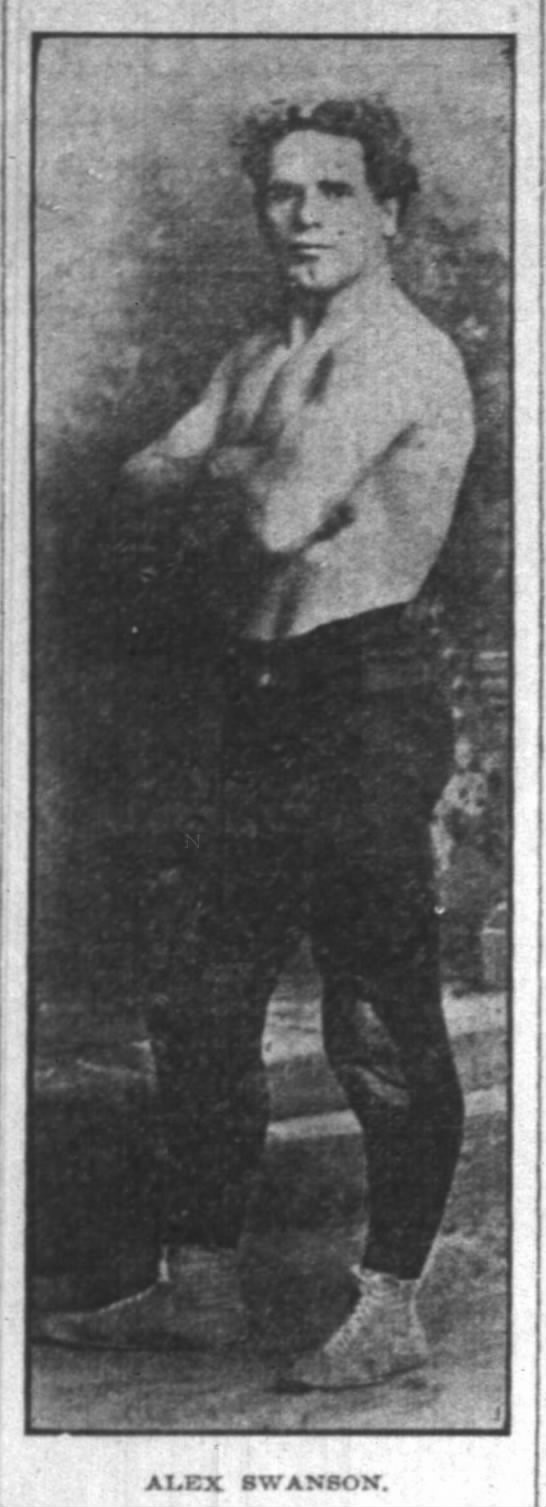
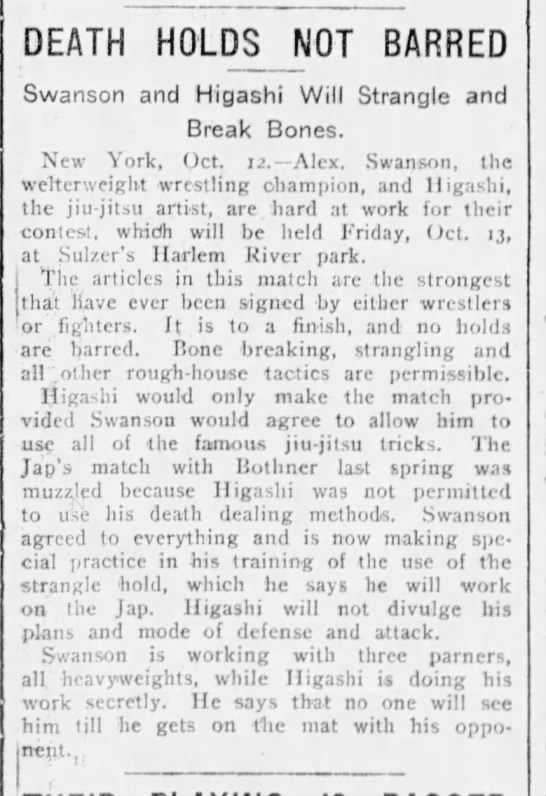
The catch wrestler had triumphed over the jiu-jitsu exponent with three falls, two by pin and one by submission with a total mat time of 25 minutes 48 seconds. In two attempts, Higashi had come up short against two skillful catch-as-catch-can wizards. The Brooklyn Daily Eagle writer declared, "…the result of this contest will likely sound the death knell of the Oriental game for competitive purposes in this country. The general impression seems to be that any ordinary wrestler of the rough and ready school could subdue a Jap with all his Jiu Jitsu tricks in an impromptu combat" (ibid, Brooklyn Daily Eagle, 10/14/05). The Sun included the statement that, "Both sides played fair and Higashi after the struggle admitted that jiu-jitsu had received as fair a test as he desired" (22).
In a footnote to Bothner and Swanson's contests with Higashi, there was an intense rivalry between the two catch wrestlers that culminated in a contest between them on January 12, 1906. Both grapplers were New Yorkers and though Bothner was a lightweight and Swanson a welterweight, they quite often squared off against opponents outside their weight classes. After years of challenges and counter-challenges, they were finally matched up to wrestle on January 12, 1906 in New York City. Bothner's lightweight championship would be on the line, if Swanson made 139 pounds at ringside. Bothner prepared for the contest honing up on jiu-jitsu tactics, training with Professor John J. O'Brien. The lightweight champ was imbued with the idea that a combination of jiu jitsu and wrestling will be too much for the strength of Swanson to overcome (23).
Swanson waved off the jiu-jitsu threat, stating, "I exploded the game of jiu jitsu when I defeated Higashi, the Japanese expert. After his defeat Higashi went abroad, and the other exponents of the supposed fearful bone-crushing art have kept up a powerful silence. Bothner had better stick to the game at which he won a championship and at which he is considered a wonder. I can beat him at that game, and will upset any theories he may have of the Japanese game if he tries them" (24). Swanson came into the match heavy at 143.5 pounds and his opponent initially threatened to call off the contest. There was also a dispute over the referee with suggestions ranging from Tom Jenkins to Prof. O'Brien. All parties finally agreed on old-time boxer, trainer and manager "Florrie" Barnett as the third man. "Bothner stayed on the defense throughout the bout. Swanson tried every hold he knew to turn Bothner on his back, but the champion was not to be tempted to take the offensive, and contented himself with stretching himself full length on the mat or wriggling out of holds" (25). Bothner injured his arm, breaking free from a hammerlock and refused to continue wrestling. They had been at it for an hour and a half. Two doctors examined the lightweight champ and concurred that a ligament had been torn in his arm. Barnett awarded the victory to Swanson. The whole affair was generally viewed as unsatisfactory. One critic labeled it a resting match (26).
Following his losses to Bothner and Swanson, Higashi took his act across the Atlantic Ocean to Europe. On November 30, 1905 in Paris at Bostock's Hippodrome he contested with Yukio Tani for the "jiu-jitsu championship of the world". Tani won in two minutes and 28 seconds, forcing Higashi to concede to a collar choke. The same year as Higashi's two contests with members of the American mat fraternity, a mixed match took place in western North Carolina that was indeed "anything goes" and "no holds barred", and again the catch wrestler came out as the best man. The combatants were the legit Kodakan judoka Akiatro Ono and one of professional wrestling's most notorious barnstorming side bet wrestlers Charles Olson.
Charles Olson, born in Germany in 1879 and raised in Chicago, was as good as it ever got when it came to brutal catch-a-catch-can wrestling. He was also well-versed in rough-and-tumble fighting. His real name was Max Flaskamp but he used a number of names as a wrestler and eventually had his name legally changed to Charles M. Olson. He hit the road as a traveling "ringer". Using various monikers, his modus operandi was to show up unannounced in a town that had a wrestling hero and seek work as a machinist or a cook. Olson would slowly let it be known that he considered himself something of a wrestler and was more than willing to engage any local competition in a side bet match. It wouldn't be long before the local sports jumped at the offer and brought their "local pride" to face the newcomer. Standing a lanky 6' 1" and weighing around 170 pounds, Olson did not look intimidating. The eager town sports fraternity saw him as easy picking: "this beanpole wouldn't stand a chance against their boy". Olson's backers would next show up with cash in hand to cover any and all wagers. If things worked out right, a whole series of lucrative matches could be held. Eventually Olson would wear out his welcome and move on with his pockets full.
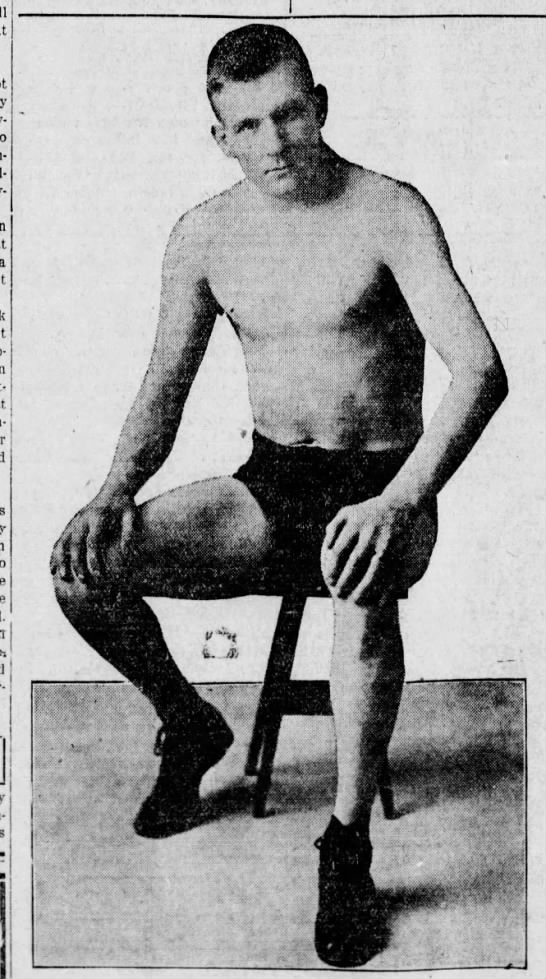
This barnstorming wrestler gimmick was part and parcel of early professional wrestling. Such mat stalwarts as Farmer Burns, Frank Gotch, Joe Carroll (Ole Marsh, J.C. Marsh), Al Ackerman (Burt Hudson), Ed Adamson (Young Beell, Wild Joe Collins), and Fred Beell were all past masters at this game. The justification was that if the locals didn't want to lose their money they shouldn't be betting in the first place. And furthermore, weren't the towners trying to take the traveling wrestler's money. In other words, in true carney logic, they deserved to be fleeced. As the author previously wrote in an earlier volume, "Olsen's livelihood necessitated he remain an unknown without any reputation to proceed him or hint at his actual prowess. Tall and thin and without the musculature of a typical professional wrestler, Olsen's appearance offered no threat to any potential opponents" (27). A Seattle sports writer commented, "Olsen is a past master of the punishing game. He is a terror to every foe against whom he is in earnest. All the bone-breaking, nerve-wrecking, heart-rending tricks of this torturing of all sports are at his command. Olsen has long stood in his own light as a wrestler. He has eked out a fortune…by wrestling under aliases in the 'bushes'" (28).
Another reporter offered, "He has more aliases than the most desperate criminal, and his defeated opponents lie in forlorn heaps…from one end of the country to the other…He does not care for the laurels of fame. Though a championship might be his for the asking, he prefers the 'coin' that lies in his methods of winning from the 'innocents'" (29). Besides Charles Olson, his noms de guerre included Harry Mayes, Lawrence Miller, Jack Carey and Jim "Kid" Cutler, and he often used the added billing of the "Terrible Swede" or the "Montana Cowboy". One commentator summed up Olson by saying that he was like the proverbial singed cat, "better than he looks". Olson and his manager William H. Barton had "cleaned out" all their prospects in the mid-west and were looking for fresh fields to conquer. They caught wind that the mountain city of Asheville, North Carolina had adopted a hefty Japanese jiu-jitsu expert as their hometown pride, so they set their sails in a south-easterly direction. Barton prepared for their arrival by firing off a challenge letter to the Asheville Citizen newspaper in mid-summer 1905. Akitaro Ono had arrived in San Francisco aboard the steamship Korea in May of 1905. He stated that he had been engaged to teach jiu-jitsu at West Point. However the military academy, after initially allowing judokas Tsunejiro Tomita and Mitsuya Maeda to give a demonstration, opted to hire former heavyweight catch-as-catch-can wrestling champion Tom Jenkins to teach the cadets wrestling, boxing and self-defense instead of a Japanese martial artist. Ono became an assistant to Yamashita Yoshiaki, a high-ranking Kodokan judoka who was teaching judo to the cadets at the Naval Academy in Annapolis, Maryland. When the academy's school term ended for the summer, Ono moved on. In July, "Professor" Ono and an entourage including "Professor" H. Koizumi, I. Sezawa and "Dr." I. Hirano arrived in Asheville and visited with local Christian Church pastor Reverend Y. Minakuchi. Hirano, who spoke perfect English and was supposed to be a Yale student, acted as the troupe's manager. Koizumi was said to have taught jiu-jitsu at Harvard University. As the martial artists settled into the picturesque city, Ono wasted no time in proclaiming himself "the world's greatest exponent of the jiu-jitsu" and the "world's challenger", giving exhibitions and defying all comers to wrestle him, offering $100 to anyone who could throw him. Though just 5' 6 ½" tall, Ono was bigger than most of his fellow traveling Japanese martial artists, weighing in at a bulky 205-215 pounds. Ono and Koizumi declared that they were ready to face anyone, even boxers.
The wandering martial artists gave an exhibition on July 20 at the Grand Opera House with demonstrations of jiu-jitsu, fencing, and "sword dancing". They repeated their open challenge. Their defis were met soon enough. First up was Koizumi, who agreed to meet a 170-pound Columbia University athlete named Phelan D. Beale at the Imperial Hotel Ball Room in nearby Hendersonville. Beale was back home for the summer. A large crowd was in attendance for the bout. As the action commenced the Japanese jiu-jitsu expert locked up his opponent and sent him sailing high in the air. Beale adroitly landed on his feet and went right after Koizumi. The collegian secured a half Nelson on his adversary and leveraged his shoulders and hips flat on the mat. Beale was declared the winner of the first fall. The bout had lasted about eight minutes. Koizumi insisted his arm had been injured in the struggle and he refused to continue. The contest was considered a victory for the young American.
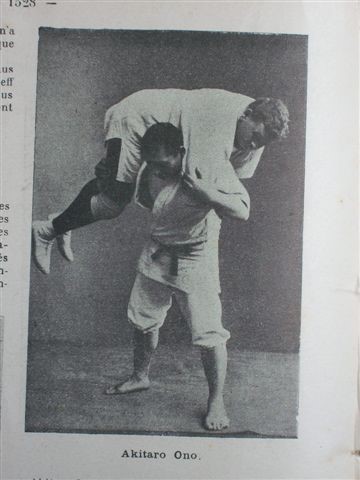
Talk had been buzzing around the environs about Ono coming to grips with "the mountain giant" Big Tom Frisbee. Big Tom, well-known throughout western North Carolina was hailed as "the strongest man in the whole state". Living in Hot Springs, NC, Frisbee stood 6' 5 ½" and weighed over 300 pounds. He is said to have been trained in Greco-Roman wrestling by William Muldoon and to be undefeated on the mat. Surely Big Tom could put the foriegners in their place, or so the local sports figured. Frisbee was willing but wanted to wrestle in alternating falls, Greco-Roman and jiu-jitsu. Ono was adamant that they would both wear gi jackets throughout the contest and that he would be allowed to make use of his full jiu-jitsu arsenal from start to finish, choke holds included.
The two powerhouses finally came to an agreement about the rules and a contest was set. It would be for the "world's championship", best two out of three falls, American wrestling (catch-as-catch-can) versus jiu-jitsu. They would wear the customary Japanese jackets and Ono was free to utilize all the jiu-jitsu he wanted. Falls could be won by forcing one's opponent into submission, holding his body down for five minutes, or pinning both his shoulders or both his hips to the mat at the same time. Striking of all kinds and "finger and wrist holds" were not to be allowed. The mat would measure 16' by 19' and be spread over six inches of saw dust. A double rope ring would surround the mat. Well-known "champion all-around athlete" and gym operator Professor Otto B. Schoenfeld from New Orleans was brought in to serve as the referee.
The bout was scheduled for August 4, 1905 at the Auditorium in Asheville and attracted an enthusiastic crowd of over 2000. Included in the throng were some 500 of Big Tom's fellow Madison County residents. There was heavy betting on the outcome with Frisbee the popular favorite. It was also advertised that there were "special seats reserved for colored people in gallery". An Asheville newspaper labeled the contest, "the most important sporting event that has occurred in this city for many years" (30). The festivities commenced with a "Japanese sword dancing" demonstration by Sezawa, followed by a jiu-jitsu exhibition with Sezawa and Koizumi. Schoenfeld addressed the crowd and explained that a fall would be registered if one man's shoulders were held to the mat for two seconds. This may have been an allusion to the controversial flying falls from the Bothner/Higashi battle, four months earlier in New York. Time for the main event was called at 9:20 pm. The combatants shook hands and the action got underway.
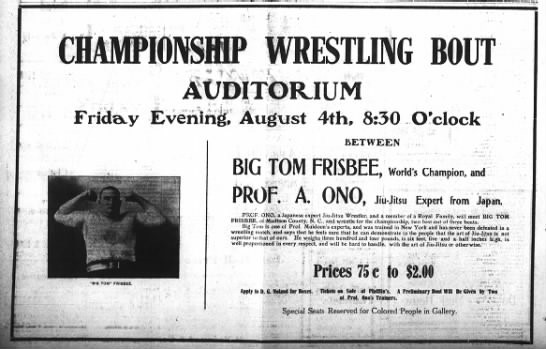
The two men locked up, pushed, pulled and tugged at one another, scrambling to secure a hold. Ono tried to get a firm grip on the giant's neck, while Frisbee worked to latch on a half-Nelson. Unable to lock on that hold, the big North Carolinian grabbed Ono's belt and attempted to leg-sweep him. The squat Japanese fighter held his ground, went on the attack and downed Frisbee. Big Tom jumped right back up, as the crowd cheered wildly. Frisbee secured a half-Nelson and leveraged Ono to his knees. Staying aggressive, the giant strove to work his grip into a full-Nelson. Ono fought off his efforts and regained an upright position. A lively exchange followed with both grapplers trying to trip each other and get their man down on the mat. Ono also tried to utilize shoulder throws but he couldn't budge the over-size mountain man. They continued grappling about on their feet. Ono finally secured a choke hold using the collar of Frisbee's jacket to commence strangling him.
What followed next was a bit confusing. Frisbee tapped Ono on the shoulder three times. Ono assumed he was signally his concession, released the grip and left the ring thinking he was victorious. Frisbee later explained that he had loosened Ono's lock around his throat and was able to continue breathing and had tapped Ono to let him know, the choke hold wasn't working. When Ono left the ring, the mountaineer thought he'd given up. Schoenfeld did his best to restore order and demanded Ono return to the mat, threatening to award the contest to Big Tom otherwise. The match resumed and Ono wasted no time in getting another collar-choke on his giant opponent. Apparently, the martial artist had his number. Frisbee struggled to resist, but as Ono twisted and tightened the folds of the collar and pressed his thumbs into the big man's neck, he was slowly choked down to the mat from where he gave up the first fall. The audience was at a fever pitch with excitement. A five-minute break was taken.
Back in his dressing room, Frisbee was ready to call it a night. He had to be convinced to return to the fray. A reporter noted, "Tom appears much worse for the wear" (31). Ono immediately went after another choke hold, secured it and brought the man mountain to the mat. Frisbee raised his hand in submission, the referee stopped the battle and declared Ono the winner. The martial artist had triumphed using collar chokes, "the Jap's 'strange holt'" as one local described it. They had contested for a grand total of 59 minutes. Frisbee's backers reportedly lost quite a bundle betting on their hero. Frisbee later offered, "He would never have bested me if it had not been for my shirt; that is where he got his hold" (32). The giant also bragged that he'd have won if the referee had allowed him to simply pick up Ono and toss him over the ropes. Frisbee voiced his desire for a return match though stipulating that he would never wear a gi again.
Phelan Beale, who had been recruited to help train Frisbee for his bout with Ono, opined, "Frisbee has a yellow streak in him. He was scared the day before the match. I discovered that and tried to brace him up. There is nothing to Jiu Jitsu to alarm any one" (33). Beale got another chance to prove his claims about jiu-jitsu in a rematch against Koizumi. The return contest was held August 29, 1905 in the Hendersonville Opera House. A packed throng of some 800 people turned out to witness the tussle. The match-up was to be held best two out of three falls, alternating between jiu-jitsu and catch-as-catch-can; with no holds barred. G.C. Westervelt of the Annapolis Naval Academy was slated to serve as the referee. Someone identified as "Prof. Fenolloski" gave a short address on the history of jiu-jitsu before the match.
The combatants, clad in traditional jackets, shook hands and then got underway. Koizumi reached out to grab Beale, who evaded his grasp and rushed in himself. Like a bolt of lightning he secured a hammerlock, took his opponent to the ground and pinned him clean. A mere three seconds had elapsed since the call of time. Koizumi protested but the ref ruled it a fair pinfall. The crowd cheered and hurrahed with abandon. The grapplers took a ten-minute break. For the second fall, the men wrestled bare-chested. Koizumi went on the offense, charged at his adversary and took him down to his hands and knees. Beale grapevined the jiu-jitsu expert's legs and brought him to the mat. What followed was a steady display of furious grappling as Koizumi went after leg, knee and crotch holds. Beale tried to secure a half-Nelson. The combatants rolled about the mat, switching top and bottom positions back and forth. Tussling around like a pair of bulldogs, they scrambled off the mat at one point and had to be restarted.
Beale quickly gained control with a half-Nelson, converted it to a full-Nelson and methodically leveraged Koizumi flat to the mat, pinning his "head, shoulders and hips" (34). The second fall had taken up about one minute's time. Despite the brevity of the match, the fans seemed fully satisfied with the night's festivities. Beale's delighted supporters carried him away on their shoulders. Three cheers were offered up for Koizumi in the spirit of good sportsmanship. Big Tom Frisbee was in attendance and was said to have been ecstatic about the outcome. Western North Carolina had played host to three jiu-jitsu versus wrestling bouts so far. The locals had taken a liking to their Japanese visitors and made them feel welcome. Jiu-jitsu was the talk of the town. Ono's clear victory over Big Tom had won him a lot of popularity and he began giving jiu-jitsu instructions at the Asheville YMCA. But a grappling tornado using the name Charles Olson was heading in the mountain city's direction and a lasting impact would be left behind. It was later reported that some of Frisbee's backers had sent word to Olson about coming to Asheville and settling their score with Ono.
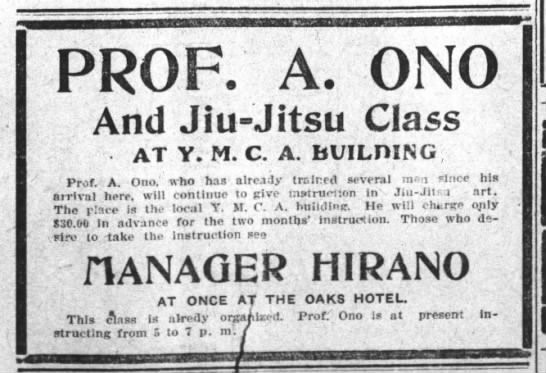
Olson and Barton arrived in town and quickly made their presence known, beginning negotiations right away for a showdown with Ono. Barton was an old hand at generating publicity. Olson worked out with Frisbee in Hot Springs. The jiu-jitsu expert and the "Terrible Swede" agreed to face off, wearing jackets, in a "jiu-jtsu rules" contest, basically meaning "anything goes". Olson readily consented to don the traditional Japanese "kimono", as he did "not want to have a single hitch in the arrangements" (35). The bout would take place on September 15, 1905 at the Asheville Opera House under the management of Gudger and Reynolds. They'd be contesting for an eight hundred dollar purse, $500 to the winner and $300 to the loser. A lot of side bet money was wagered as well. The New Orleans physical culturist Professor Schoenfeld would be brought back to Asheville to perform the refereeing chore.
The Olson/Ono fracas was billed as a "Blood Match", meaning it was the "real deal" and the contestants were "out for blood" with money on the line. The Asheville Citizen reported of the camps, "Both are confident that their man will win and both have plenty of money to back their opinion" (36). Barton intimated that if Olson indeed proved victorious they would likely remain in Asheville through the winter. The upcoming contest was said to be the main topic of conversation in the "clubs, hotels and street". A preliminary match was planned with Koizumi meeting a "local amateur" for a $50 purse. It was hoped to bring Beale back to battle Koizumi yet again. Beale initially expressed his willingness to tackle Koizumi in a third rematch, but insisted that any winnings he received would have to be donated to charity, so as not to affect his amateur status. There is no record of the prelim ever occurring, so apparently things fell through and the main event served as the night's only entertainment.
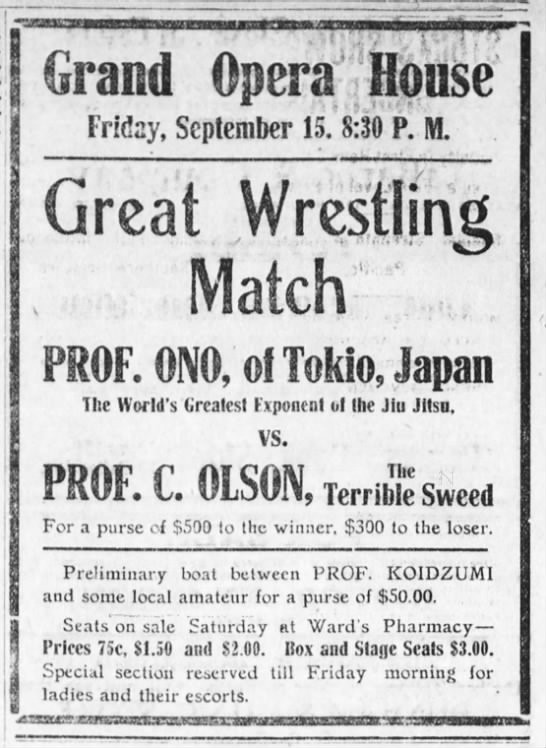
A huge throng of some 1200 people packed the venue for the contest, filling the main floor, gallery and balcony. An eighteen-foot square mat was spread on the ground with just 2.5 inches of padding by request. It was determined that the lesser cushioning would allow for faster footwork. A rope separated the mat from the press tables, the special seating and the big crowd of spectators. It was noted that betting had continued right up to the opening of the doors. Barton remarked, "I never saw so much money bet on a wrestling match in my life", then added, "no doubt with dollar signs flashing in his eyes, It's a great town, Asheville" (37). Schoenfeld addressed the crowd, explaining that "jiu-jitsu rules" basically meant that "each man must look out for himself and that everything is permissible" (38). The Professor further clarified that actually "finger holds", meaning single digit manipulations would be barred, and that "unless it appears to me there is unfair practice, the man who suffers loses…pin holds count, this is while I count one, two, three". He then proceeded to introduce Olson as "one of the best wrestlers in America" (39).
The combatants lined up on opposite ends of the mat. One sportswriter noted that Ono "looked like a solid rock wall in comparison to the slender build of his opponent" (40). The men, both clad in jiu-jitsu jackets, shook hands and then separated. Olson instantly shot in low for a leg takedown. Ono cleverly dodged the incoming wrestler, grabbed a neck hold and forced Olson face-down on the mat as the crowd cheered wildly. Olson powered himself free and sprang up like a flash, again to the loud applause of the spectators. Excitement was definitely in the air. The catch wrestler launched a head butt at Ono, but succeeded in only ramming his neck. Both combatants fought for arm holds in a display of stand-up grappling. As the Japanese martial artist struggled to secure a grip, Olson responded with a flurry of head butts, or as the Asheville Citizen called them, "the head ram" (41). Ono gained control of his adversary and threw him down, locking on a half-Nelson and attempting to pin him. Olson resisted, kept his shoulders off the mat and bounced back to his feet, immediately nailing Ono with another butt.
Olson locked up Ono with a body hold and tried to get a strangle hold. Ono was having none of Olson's offense and promptly hip-locked him. The catch wrestler landed on one shoulder but "quick as lightning came up again" (42). The fans were exuberantly cheering both men. Fast-paced grappling and rough-housing continued into the 40-minute mark. Both contestants went after neck holds, strangles, hammerlocks, hip-locks and shoulder holds. Olson continued to hammer Ono with head butts. In fact, one sportswriter noted that he was "butting mercilessly" (43). Ono was bleeding from his face and mouth and the blood began to splatter on the mat and on Olson's jacket. "The claret flowed", using the terms of an old-time prizefight. It was a fierce and brutal competition, with both fighters giving and taking punishment, attempting leg trips and choke-holds. Olson managed to secure the better grip and started to twist Ono's collar around his throat. Hirano and another cornerman rushed into the ring, screaming that their man was being horribly fouled. Attending policemen chased after them and forced them back to the other side of the ropes. It was noted that Ono's face was "rapidly swelling and one eye was closed" (44).
Hirano again frantically ducked under the ropes and charged into the ring. Olson saw him coming and quickly nailed him with a swift kick, sending Hirano flying across the mat. The fans were at a fever pitch, standing and yelling wildly. Olson's corner was shouting, "Put the Jap out!" Schoenfeld asked Ono if he'd had enough and was ready to give up. Ono gamely declined the referee's offer to end the battle. "The wrestling and butting continued" (45). Olson had a tight grip around Ono's collar, twisting it around his neck while smashing him with butts. Ono managed to stagger to the edge of the mat, both men still gripping one another firmly, and conceded the first fall. It had been one hour and ten minutes since the combat commenced. Ono's eyes were swollen shut and his face was bloodied.
The crowd was mad with excitement with a quite a few standing on their chairs yelling and screaming. Schonefeld announced that Ono had given up the first fall. Olson, smeared with Ono's blood, stood tall and smiled at the crowd. Hirano helped Ono make his way to the dressing room. It was soon announced that Ono was completely done in and was unable to return for a second fall. Olson's backers went wild with joy (46). Ono had gotten a taste of North American rough-and-tumble fighting combined with catch-as-catch-can wrestling at the hands, and head, of a skilled practitioner. Schoenfeld told the crowd that he was sorry that they had witnessed such a brutal fight. Olson declared that he had come a long way to meet Ono under the "Japanese style". He stated that his opponent "tried to break, and would have broken his arm if he could and that he had defeated the challenger under the rules of jiu-jitsu (47). Schoenfeld added to the excitement by challenging Olson to a contest, under catch wrestling rules" (48).
Thousands of dollars are said to have changed hands on the outcome. The Madison County men, in particular cleaned up, with Frisbee alone pocketing $1500. Olson reportedly picked up $10,000 in backing himself to win. A Charlotte writer labeled the contest a "butting and biting contest" (49). Another newspaper man called it a "battering match" (50). Schoenfeld went on to defend his officiating, saying that it was mutually held under "jiu-jitsu rules" and that at any time either men could have given up. Hirano was busy protesting that his man had been horribly fouled with finger holds, punches and biting. Olson replied that he only started his butting tactics after Ono had attempted to break his arm, and further that Ono had bitten him twice, exhibiting teeth marks on his arms. A Charlotte editorial summed up the general feeling, "Mr. Ono lost at his own game to a smaller man" (51). As Ono left town to recuperate, Hirano made his way up to Washington DC to lodge complaints with the Japanese legation and attempted to take the matter all the way to President Theodore Roosevelt. The Asheville political authorities ruled that no more "blood matches" would be allowed in their environs.
In true barnstormer fashion, Olson quietly slipped off to St. Louis, Missouri where a private side bet contest had been set up. St. Louis had a local amateur wrestling star in the person of Frank X. Kugler, a young German immigrant. Kugler represented America in the 1904 Olympics Games held in St. Louis and competed in wrestling, weightlifting, and in the tug of war event. Winning three bronze and one silver medal, Kugler remains the only individual to have medaled in three different sports at the same Olympics. A group of wealthy backers arranged a match between Kugler and "L.M. Miller" to take place for a $1000 a side at the St. Louis Turner Hall on September 23, 1905. "Miller", Olson in a farmer disguise, showed up ready for action, best two out of three falls. Beyond the side bet purse, an undisclosed amount of additional money was also wagered.
Olson had played his country bumpkin part to the hilt, and Kugler's backers were convinced that they had a sure thing. Some hayseed had come to town thinking he could out-wrestle their world-class champion. When time was called, Olson unleashed his prowess and gained straight falls at eleven minutes and two minutes respectfully. Kugler got desperate trying to protect his backers' money and actually attempted to eye-gouge the ringer. Olson, though victor, was left with a badly scratched up nose. Olson, pockets bulging with cash, returned to Asheville. Olson and Barton would set up their headquarters there for the next year. Some of the greatest wrestlers in the country were brought to town to square off with Olson, including heavyweight champion Frank Gotch, Farmer Burns, Lancashire wrestler Jim Parr, Baltimore "Strong Boy" Shad Link, and Emil Klank, who appeared under the name Dan McDonald. Olson faced Gotch twice in the city, actually winning the second fall from him in a three falls contest and holding him to a draw in a return bout. In two matches against Burns, he won once and lost the second time. From their mountain city base, Olson also made occasional forays around the southeast. For a brief span, Asheville became the wrestling capital of the nation. Groups of children would follow Olson as he walked around the streets.
In early October Olson was badly cut up during a street brawl, suffering knife wounds in his leg, hand and chest. Sam Murbarger, a capable wrestler from Indianapolis, was brought in to fill mat dates already planned for Olson while he recovered. Olson remained in Asheville until August of 1906, after losing a bout to Farmer Burns.
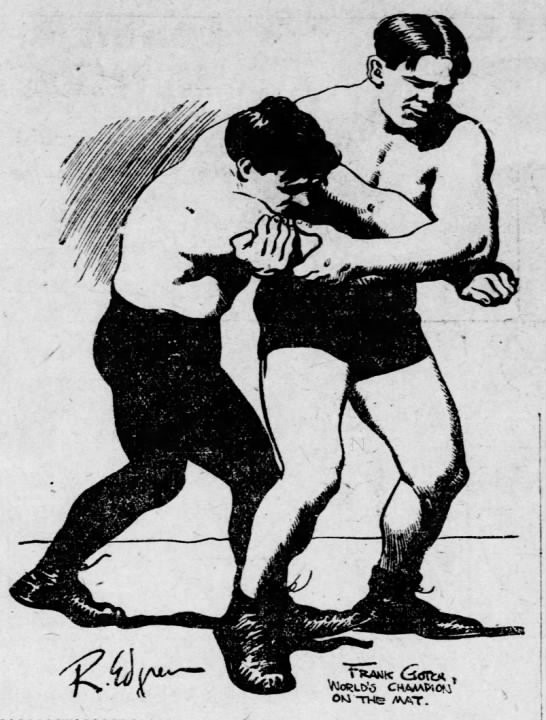
Ono returned to Asheville himself in November, bringing along fellow Kodokan judoka Mitsuyo Maeda. Maeda, of course, would go on to become an international legend as the "grandfather of Brazilian Jiu-Jitsu". But at this stage of the game he was just one of several itinerant Japanese martial artists giving exhibitions, taking part in challenge matches and dabbling in professional wrestling. Ono resumed giving jiu-jitsu lessons at the YMCA. At an Elks Lodge "smoker" Ono and Maeda gave a demonstration of their art, "The spectators watched with much interest as the Japs showed the various forms of attack and watched the big men throw each other on the mat from all conceivable positions" (52). Maeda and Ono headed to Atlanta and gave an exhibition match at the Atlanta Athletic Club on December 5, 1905. A mixed-style match was arranged between Maeda and Olson/Barton associate Sam Murbarger. The bout took place at the Grand Theater on December 18, 1905.They would wrestle alternating "Japanese style" and catch-as-catch-can falls with Olson serving as the referee. Olson, billed as the "Montana Cowboy" was also ready to meet all comers and offered $50 to anyone he couldn't throw in 15 minutes.
The opening round was held under jiu-jitsu rules with both grapplers wearing jackets. Maeda tossed his opponent in twelve minutes. Next up was catch wrestling and Murbarger proved the winner after a 28-minute struggle. Back in Maeda's specialty, the jiu-jitsu exponent beat the American in 8 minutes and won the contest. There were no takers for Olson's open challenge. It was observed, "Outweighed by twenty pounds at least, the athlete from the Orient, carried off all the honors of the evening, and before the finish of the three falls had won the sympathy of the major part of the audience…In the catch-as-catch-can fall, which style of wrestling Atlantans understand better than the jiu-jitsu, Murburger seemed confident of winning, but apparently relied more upon bodily strength and weight than he did upon skill at the game. Once he almost locked a full nelson and then lost it, several times his half nelsons failed to work, while the hammerlock was totally ineffective. The fall which he finally obtained came more as the result of the gradual pressing of his body against that of the lighter Jap than as the result of any particular grip or hold" (53). Another Atlanta newspaper reported, "Score another one for the wily Jap…When Professor Maeda is under a full head of steam, greased lightning should be classed with the 'also-rans'". Murbarger commented after the match, "If you ever hear of that Jap mixing it up with anyone else soon, just let me know, I'd like to put all my money on this unbeatable phenomenon" (54).
Maeda was next reported to be headquartered at the YMCA in Selma, Alabama. Both he and Ono would venture to England and on to continental Europe, where they would participate in numerous contests at both wrestling and jiu-jitsu. In England especially, Maeda participated in many catch-as-catch-can bouts and became quite proficient at this style of grappling. Maeda's greatest successes would come in Mexico City, Havana, Cuba and then later in Brazil, where he would leave a lasting legacy. Ono used the name Diabutsu when he appeared on the British music hall circuit, offering a cash prize to anyone who could last ten minutes with him on the mat under jiu-jitsu rules. He eventually returned to Japan where he died of typhoid fever in 1921. Olson had a second encounter with a Japanese martial artist a year after his wild and wooly bout with Ono. This encounter took place in New Orleans on June 4, 1906. This time the match seemed to be typical professional wrestling fare. His opponent was a regular on the circuit and used the names Koto Harada and Arata Suzuki. There was some pre-match haggling over wearing jiu-jitsu jackets and Olson finally consented to don one. The arrangements were that jiu-jitsu rules would prevail until Harada won a fall and then they'd switch to catch-as-catch-can. Olson won the first fall, Harada the second and Olson took the third and final.
The itinerant barnstormer returned to the Carolinas in the summer of 1907 ready to defend his claim to the Championship of the South. Back in Asheville he defeated Chris Pearson in a "genuine blood match" for the "championship of the South". A rematch held the following month, with the strangle hold allowed, saw Pearson conquer Olson. The contest turned into a rough-and-tumble with "shoving, slapping and butting". Pearson commented, "I simply beat Olson to it with the strangle hold, that's all. He would have used it on me if I had given him the chance" (55). It was noted that there was heavy betting on the match, with the odds favoring Olson, possibly indicating a betting scam. That was not an unusual thing in early 20th century pro sports.
Olson had a very rough bout with James Prokos in St. Louis, MO on November 25, 1907. Each wrestler put up a side bet of $450 and veteran mat man George Baptiste handled the refereeing job. Olson won two straight falls in what was described as "the fiercest wrestling contest ever witnessed in St. Louis". Prokos was "almost killed" and was left unconscious and bleeding from his ears, nose and mouth. It took a half-hour before Prokos could be revived (56).
Early in 1909 Olson was out with a challenge to the big, barnstorming self-proclaimed "jiu-jitsu champion of the world" Leopold McLaglan when the latter made an appearance in St. Louis. McLaglan was more bluster than bite and after making a show of accepting the defi moved on to safer surroundings. It was noted, "Olson likes nothing better than to meet a jiu jitsu man" (57).
Later Olson offered some comments about jiu-jitsu. He told a reporter in Albuquerque, New Mexico, "I have seen the Japanese system of wrestling, the widely heralded jiu-jitsu, tried out pretty thoroughly a good many times and my conclusion is that it is a false alarm. In my opinion jiu-jitsu got its vogue while the Japanese were in the limelight during the war with Russia and there is a great deal of superstition about it. I have seen the Japanese go up against some of the best catch as catch can wrestlers in America and in no instance have I seen the Jap make good or even make a creditable showing against the ordinary method of wrestling. As a means of getting the best of an ordinary man who is not a trained wrestler the famed jiu-jitsu may be all right; but try it out with a man who knows the game and the Japanese is quite out of the running" (58).
In the interview, Olson humbly declined to boast of his own achievement in downing Ono back in Asheville. Though called "one of the most dangerous men on the American canvas" by no less than Frank Gotch, Olson was easy-going and unassuming in everyday life. Over his mat career, tragically two of his opponents were fatally injured with broken necks while engaged on the mat with him. He invested his wrestling earnings in the motion picture/theater business and was able to retire a well-to-do man, passing away in 1945.
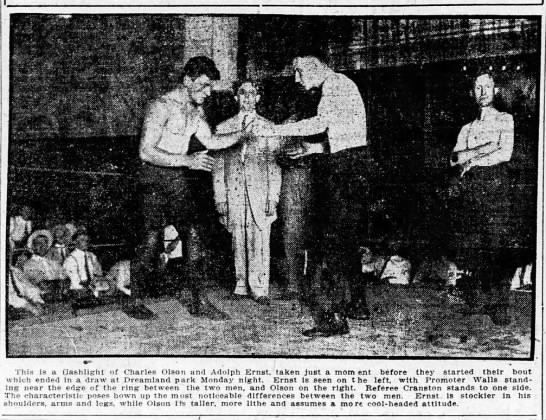
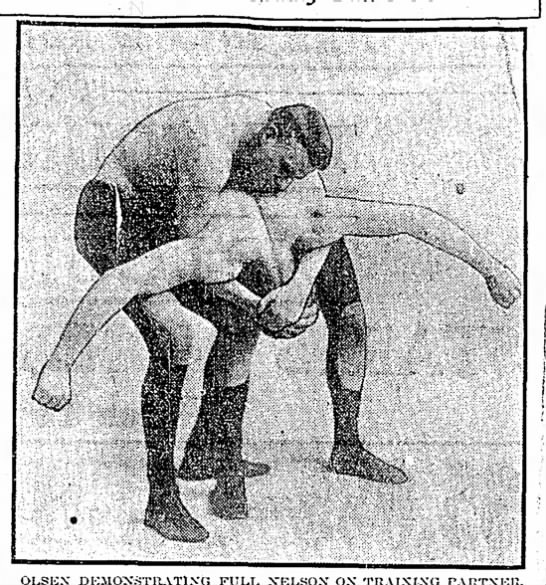
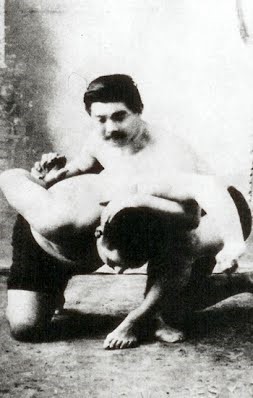
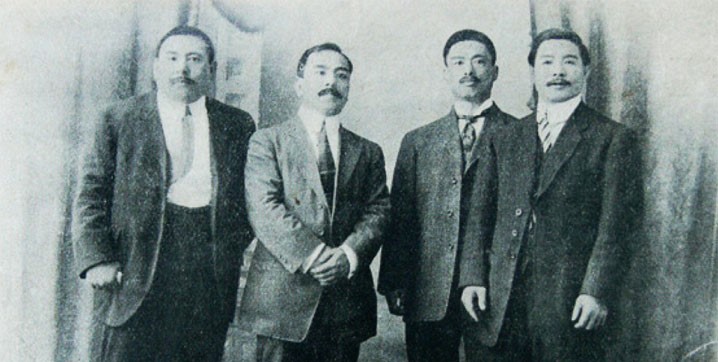
Footnotes:
1.) For more information about the origins and early years of Lancashire catch-as-catch-can wrestling see Ruslan Pasheyev's recent research masterpiece The Story of Catch.
2.) Minneapolis Journal, 5/3/1905
3.) Winfield Daily Free Press, 2/7/1905
4.) Deadwood Pioneer-Times, 3/28/1905
5.) Coschocton Daily Age, 3/28/1905
6.) Tom Jenkins took on George Bothner on 12/22/1903 in New York in a handicap bout. Jenkins agreed to throw the lightweight 5x in one hour. Jenkins weighed in at 196 pounds to Bothner's 142. When the time had expired Rough Tom had only managed to score three falls, thus losing the handicap contest. Bothner also held his own in handicap matches with Butcher Boy- John Piening and Leo Pardello.
7.) New York Evening World, 3/28/1905
8.) Chicago Inter-Ocean, 3/12/1905
9.) Outing, December 1905
10.) New York Herald, 4/7/1905
11.) Catch Wrestling/Mark S. Hewitt; Paladin Press, Boulder, CO, 2005; pages 53-57
12.) New York Times, 4/8/1905
13.) From Milo To Londos/Nat Fleischer; C.S. O'Brien, Inc., NY, NY, 1936; page 30; Evening Sun, 1/12/1925
14.) El Paso Herald, 5/1/1921
15.) The Tennessean, 2/21/1907
16.) Rochester Democrat and Chronicle, 10/11/1905
17.) New York Evening World, 10/3/1905
18.) Ibid
19.) Butte Daily Miner, 10/12/1905
20.) Brooklyn Daily Eagle, 10/14/1905
21.) The Sun, 10/14/1905
22.) Ibid
23.) St. Louis Post-Dispatch, 1/8/1906
24.) Richmond Times-Dispatch, 1/12/1906
25.) New York Times, 1/13/1906
26.) Minneapolis Journal, 1/21/1906
27.) Catch Wrestling/Mark S. Hewitt; Paladin Press, Boulder, CO, 2005, pages 69-70
28.) Seattle Daily Times, 2/7/1911
29.) Rock Island Argus, 7/3/1905
30.) Asheville Citizen, 8/4/1905
31.) Asheville Citizen, 8/5/1905
32.) Ibid
33.) Ibid
34.) Asheville Gazette-News, 8/30/1905
35.) Asheville Citizen, 9/10/1905
36.) Asheville Citizen, 9/8/1905
37.) Asheville Gazette-News, 9/16/1905
38.) Ibid
39.) Asheville Citizen, 9/8/1905
40.) Ibid
41.) Ibid
42.) Ibid
43.) Ibid
44.) Ibid
45.) Landmark, 9/19/1905
46.) Asheville Gazette-News, 9/16/1905
47.) Ibid
48.) Olson accepted Schoenfeldt's defi. A handicap contest was arranged for 9/29/1905. Olson agreed to throw the professor twice in one hour even though he was the lighter man. Schoenfeldt weighed 185 pounds to Olson's 170. The barnstormer pinned the professor for the first fall in 25 minutes. Schoenfeldt insisted he hadn't been thrown and that furthermore Olson was using foul tactics. Barton offered to restart the match with a clean slate, but Schoenfeldt refused to get back on the mat. An unsuccessful attempt was made to have Frisbee fill in and finish out the bout with Olson.
49.) Charlotte News, 9/17/1905
50.) Asheville Gazette-News, 9/16/1905
51.) Charlotte News, 9/17/1905
52.) Asheville Citizen, 11/8/1905
53.) Atlanta Constitution, 12/19/1905
54.) The Forgotten Golden Age of Mixed Martial Arts Part IV/John S. Nash; http://www.cagesideseats.com
55.) Asheville Citizen, 8/27/1907
56.) Western Sentinel,11/29/1907
57.) Indianapolis News, 1/22/1909
58.) Albuquerque Journal, 7/21/1909
Early catch-as-catch-can versus jiu-jitsu/judo contests to 1910 (Note: All these bouts were held under no-holds-barred, mixed styles, or alternating falls rules)
9/5/1904-Bellingham, WA-Frank Gotch beat K. Aoyogi
2/27/1905-Salt Lake City, UT-Eddie Robinson beat Kaduro Murayama
3/8/1905-Baltimore, MD-Columbus beat Hako
3/17/1905-St. Louis, MO-George Baptiste beat Arata Suzuki (Harada)
4/6/1905-New York, NY-George Bothner beat Katsukuma Higashi
7/26/1905-Hendersonville, NC-Phelan D. Beale beat Koizuma
8/4/1905-Asheville, NC-Akitaro Ono beat Big Tom Frisbee
8/29/1905-Hendersonville, NC-Phelan D. Beale beat Koizuma
9/15/1905-Asheville, NC-Charles Olson beat Akitaro Ono
10/31/1905-NY, NY-Alex Swanson beat Katsukuma Higashi
11/3/1905-Rockford, IL-Emil Klank beat Arata Suzuki
12/18/1905-Atlanta, GA-Mitsuyo Maeda beat Sam Murbarger
6/24/1906-New Orleans, LA-Charles Olson beat Arata Suzuki (Harada)
1/21/1909-Vancouver, BC-Matty Matsuda beat Fred O'Neill
1/24/1909-San Francisco, CA-Shosha Yokoyama drew George Braun
4/10/1909-San Francisco, CA-Shosha Yokoyama beat George Braun
5/30/1909-Los Angeles, CA-Shosha Yokoyama beat George Santell
6/26/1909-Los Angeles, CA-Eddie Robinson beat Shosha Yokoyama
9/2/1909-Seattle, WA-Tokoguro Ito beat Eddie Robinson
11/12/1909-Seattle, WA-Tokoguro Ito beat George Braun
1/22/1910-Mexico City, Mexico-Hjalmar Lundin beat Nobu Taka (Satake)
1/23/1910-Mexico City, Mexico-Mitsuyo Maeda drew Hjalmar Lundin
1/24/1910-Mexico City, Mexico-Nobu Taka (Satake) beat Hjalmar Lundin
3/16/1910-Seattle, WA-Tokoguro Ito beat Julius Johnson
5/10/1910-Guadalajara, Mexico-Mitsuyo Maeda beat Fred Beall (Note: This was not the famous wrestler Fred Beell from Marshfield, WI)
11/24/1910-Ogden, UT-Ed Ferguson beat Shosha Yokoyama
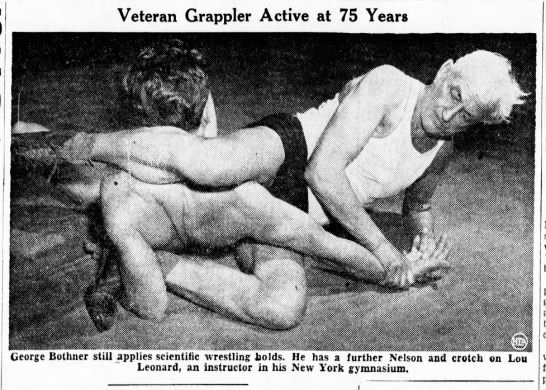
Additional Notes on Bothner: Besides his match with Higashi, Bothner also faced tough jiu-jitsu fighter and pro wrestler Taro Miyake. Miyake had been making hay on the combat sports scene in Europe when World War I erupted. He made his way to the US and proclaiming himself the jiu-jitsu champion of the world challenged everyone from Frank Gotch on down to meet him on the mat. Bothner accepted the defi and it was arranged for the 160-pound Miyake to throw Bothner 3x in a one-hour handicap bout under catch wrestling rules. Held 12/14/1914 at Brown's Gymnasium in NYC, the contest was described as "fast, furious and exciting wrestling". Miyake gained a fall in 22:12 with a half Nelson and leg hold. But afterwards Bothner managed to throw Miyake with a full Nelson, thus winning the handicap contest. Miyake challenged for a rematch under jiu-jitsu rules, but Bothner announced his retirement. He made a few more forays on the mat but spent most of his time refereeing, coaching and operating his gym. The grand old man of catch-as-catch-can passed away in 1954. This article is the second in a series exploring the roots of modern Mixed Martial Arts. Upcoming articles will include Wim Ruska versus Ivan Gomes, Judo Gene LeBell versus Milo Savage, John Pesek versus Nat Pendleton, Taro Miyake versus Will Bingham, and old-time wrestler William Demetral versus three boxers on the same night.
Comments, corrections and questions are always welcomed at: [email protected]
Mark S. Hewitt/Combat Sports Research 2019 (last update 2/21/19) Laurel, DE
